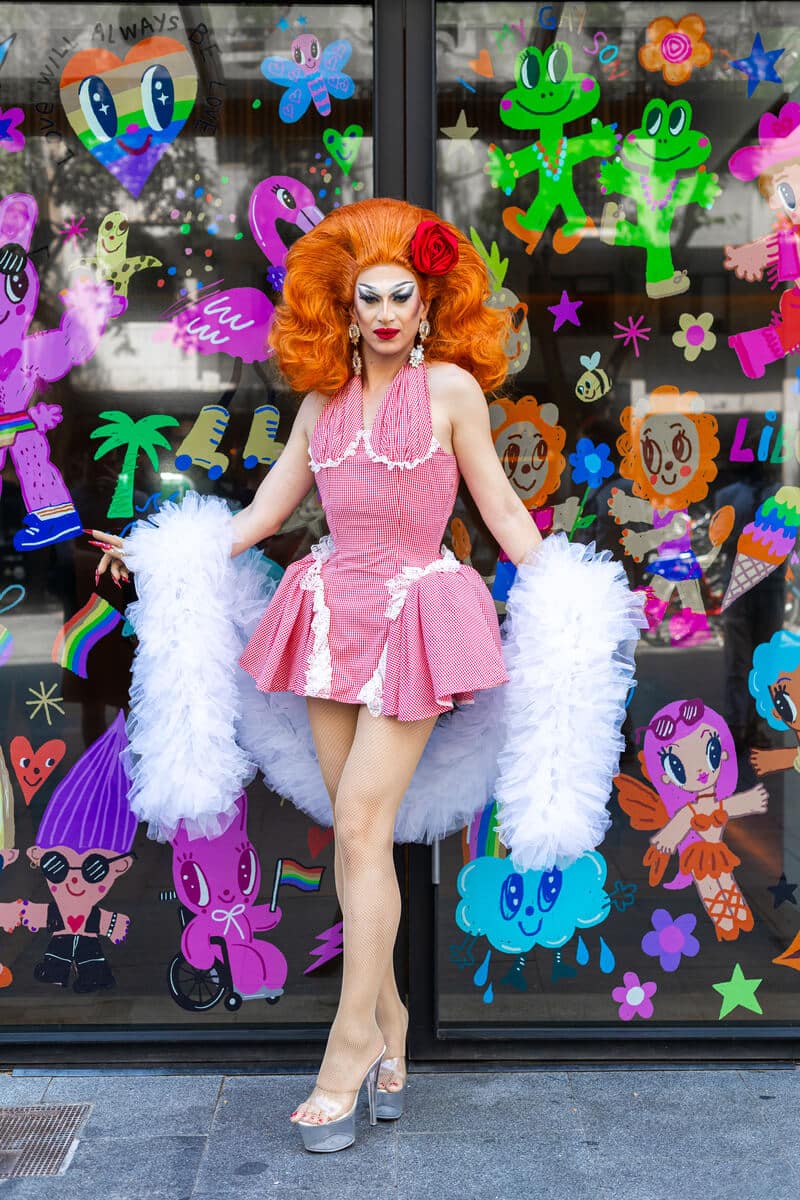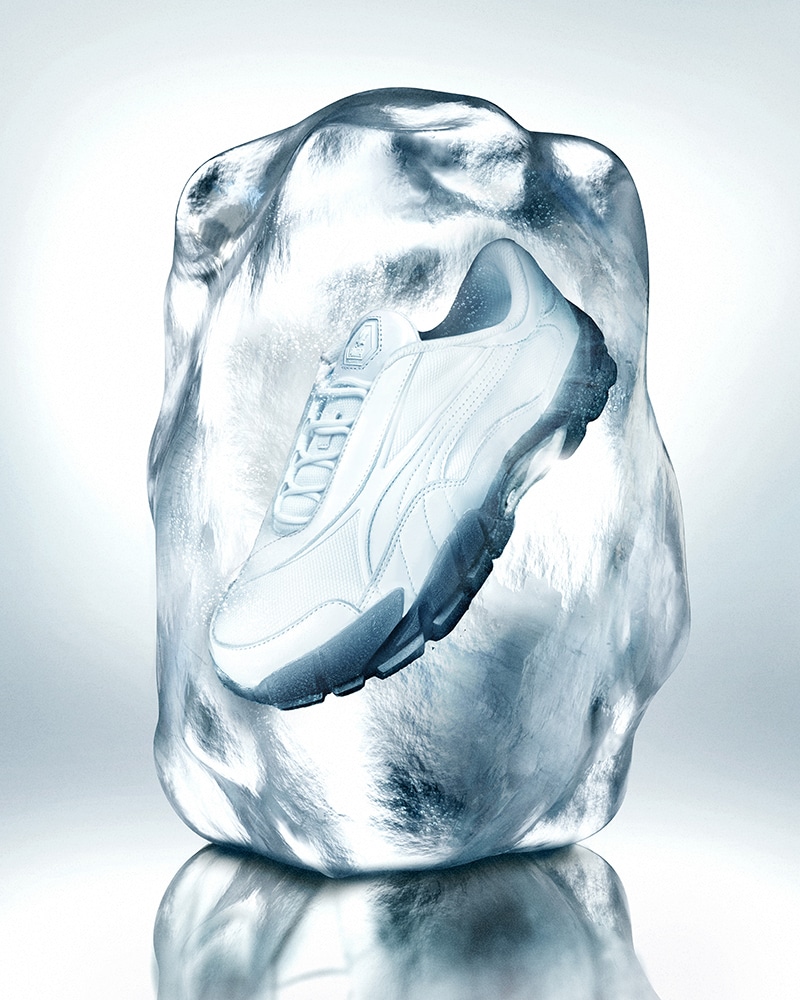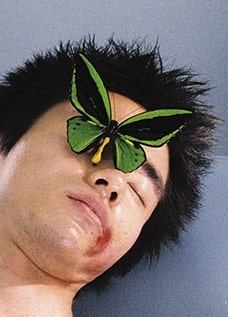
Kristian Guerra by Francesco De Luca
“I ain’t afraid of no ghosts”. In 1984, Ray Parker, Jr. is the haunting ghost in an American neon-home. In aid of the provocative owner, the Ghostbusters’ team – that in those days is all the rage in half the world’s cinemas. Refrain of the homonymous hit that also becomes the cult movie soundtrack, I ain’t afraid of no ghosts brings us thirty years back: when ghosts were bad and hunters heroes.
2014. Things seem to have changed. The sloppy white sheet of our evanescent friends is no longer fashionable. Replaced by design items with a fresh and innovative aesthetic, it becomes an object of desire thanks to the GHOSTWEAR PROJECT. Kristian Guerra is its young founder and owner. With the prestigious Limonta – historical textile company known today for its high-quality technical fabrics – and the team of Fashion 3000 Progetto e Ricerca – design atelier and styling studio that, since 2001, have managed to dominate the market with its professionalism – he wants to develop new points of view in fashion, moving across iconic garments and urban sub-culture influences.
Graduated in 2011 at IUAV University in Treviso, Kristian is immediately appreciated. In the same year, he presents his visionary down jackets capsule collection entitled A.M.E.N. which grants him the finals at the 10th edition of ITS – International Talent Support – where he is the first Italian to win two prizes: The Fashion Special Prize and The D – La Repubblica Prize. Soon after here they come the collaborations: from Max Mara and Diesel to the partnership with Limonta.
On the occasion of The Latest Fashion Buzz – the event promoted by Fondazione Pitti Discovery along with L’Uomo Vogue and GQ Italia – the designer introduces his capsule GHOSTWEAR URBAN UNIFORMS/FLAT GARMENTS: a collection combining denim influences and technical constructions… Ghosts are the protagonists, at last.
Fucking Young! – Welcome Kristian! Let’s retrace together your young career. Which are today the difficulties that an emerging designer has to face?
Kristian Guerra – Italy is living now a moment of change. For the youngsters it is even more complicated if the product they propose is out of the royalties we are accustomed to. This happens especially when a product is by an Italian producer. Conversely, when it is by a foreigner it seems to be perceived in a different way and understood immediately. I think this is due to our cultural stamp. However, maybe something is changing. If till some time ago the male fashion had had a specific taste, now this starts to oscillate because there are different needs.With the new requirements it is certainly difficult to work and stand out but it is also more interesting, more dynamic.
FY! – Now, let’s step back to your background. When did you realize fashion would have been your future?
KG – I’m from Veneto, grew up in Padua. Since childhood I have been attracted by the world of art. I attended the art school and by the time I realized that working in fashion was the best way I had to express myself. In this field you have the opportunity to work in very close contact with other people while transferring your own way of seeing things to/on themdirectly. The fact that each person is unique and follows or not a style leads to working in a transversal way. After high school I studied at the IUAV in Treviso. The course, directed by Marialuisa Frisa, had and still has a different setting than the other ones in Italy. Already during the university career, everyone can choose the road they want to go next. I realized that the fabric was the only element able to bring my features out and I focused on it right from the beginning. For the graduation collection, I worked at the production of an ad hoc fabric with which I then created a number of plumaged items. This is an important point, a critical step in my journey since creating so complex items forced me both to look up and turn to a sponsor who could believe in my project and to engage with the manufacturersimmediately. It became clearer how to work with a manufacturing company and this allowed me to improve my skills and expand my knowledge in order to become stronger. Then, there was the opportunity to participate at the ITS in Trieste with the two-time awarded collection A.M.E.N. – I have been the first Italian to win two awards. The competition gave me the opportunity to enter an international system. I was already working with a company producing feather items for a foreign market, namely the Eastern one. After ITS I started working with more companies. Max Mara was one the firsts, followed by Bonotto, local supplier for fabrics: two distant worlds allowing me to focus on two different aspects of this job. Gradually, things grew. It arrived Diesel and finally Limonta, an Italian leader in technical fabrics. They were the ones who asked me to represent their label during the fairs in Milan and Paris. It’s when GHOSTWEAR was born. The goal was to enhance one Italian textile company’s ability by producing specific cloths and presenting them in a different way. We created panels representing half an item. We focused on ghosts: the items could be seen but not completely read. GHOSTWEAR was supposed to be a project joining different points of view: the strength of a textile company, the vision of a designer, the ability of a technician-modeler. The project was so much enjoyed that we continued for two further seasons. Having the possibility to work with those who create the raw material opens a new world to be explored in front of you. You are able to control the entire planning process. I have “espoused the cause” and this year we have decided to go on with the cooperation while making it more mature and creating a wearable and salable collection. GHOSTWEAR URBAN UNIFORMS/FLAT GARMENTS, presented during Pitti86, is the result.
FY! – Why did you decide to focus on menswear?
KG – Primarily because I am a man and it is certainly a world which I feel closer to; moreover, I often have the sensation that male fashion is boring. Not so much for the items and its details as for the approach. In menswear much less things are granted because you have the idea of a standardized man. For example, the Italian man, who among other things is changing, is very different from the foreigners. To try to work with a slightly different approach has been an incentive: to be creative in an aseptic landscape. The fact that the male fashion is a bit more measured allows me to come out more incisively with respect to the femaleone that is already full of contents and much more creative.
FY! – The item that you prefer to create and the one that you prefer to wear?
KG – The former is the outerwear because it is probably one of the most important elements in a look. Personally, instead, I have a real obsession for shoes. In my opinion, both these items, more than others, are able to bring out one individual’s personality. Among other things, for GHOSTWEAR I also worked at a collection of outerwear integrated with shoes.
FY! – With and through GHOSTWEAR – as you’ve mentioned earlier – they came Pitti Uomo and The Latest Fashion Buzz: the project promoted by Fondazione Pitti Discovery in collaboration with L’Uomo Vogue and GQ Italia. What about this experience?
KG – I got there also thanks to the ITS contest in Trieste where I knew Sara Maino from Vogue. I kept in touch with her over time and not long ago she gave me a chance to meet and update her about my career. At that time Sara told me about the opportunity to participate at The Latest Fashion Buzz. I thought it was a wonderful initiative and I accepted immediately. It is important to say that I was able to attend the event thanks to Limonta and a second partner, a strong part of the project, that is Fashion 3000 Progetto e Ricerca: a service in Brescia which worked to develop the entire project. I thank them all for supporting me. Today, after The Latest Fashion Buzz, a new world is opening. It has been the first real opportunity to come into direct contact with both the market and the buyers, it radically changed my point of view.
FY! – Let’s focus now on the collection you presented in Florence. The mentioned GHOSTWEAR URBAN UNIFORMS / FLAT GARMENTS is a research project on down jackets and outerwear at large. Do you want to talk about?
KG – Including 5 outerwear and two pairs of pants, the collection is relatively limited. The five coats represent the five different types of clothing that are commonly used, there in any wardrobe. We have created denim jackets, bombers, trenches, etc… Models that people know in fact. The manner in which they were developed derived from my path and my origin in the sense that in me there are a number of references to the world of denim but to the technical and sporty outerwear as well. The attempt I made was to combine the two. They came out pieces characterized by a particular technicality – in the management of the pockets and the construction of the item itself – but with a number of references to the world of denim such as some stitching techniques. The most interesting thing is probably the combination of cotton with some peculiarities making it almost technical. The development, as I said before, was brought forward by Fashion 3000 Progetto e Ricerca, which is very strong and works in a transversal way: from items in heavy feather to lighter ones.
FY! – You told us the direct contact with the buyers has to some extent changed your point of view. How and why? That being so, what could the project that Kristian will present in a year be?
KG – Definitely it makes you more aware. Anybody knows a clothing item should be beautiful, have a good price, be well managed. However, these things become much clearer only when you attend a fair and discuss with a buyer. In a collection it is important to be creative and offer the public your point of view, even if it’s extreme, but you need to understand that your tastes should also be tempered to reach the same public in a more direct way. If I should imagine myself in a year, I hope I will be able to go forward with the project. I believe the work will continue in the undertaken direction: joining a creative and exasperated point of view with a number of aspects so that the creativity can be tempered and the items made more appealing. I am firmly convinced that it is important to satisfy a number of people but it is impossible to satisfy all of them. Often, while trying to expand the market the product risks to get flattened while you risks to lose your identity.
FY! – How will the F/W2015-16 be? Is everything still at an embryonic stage?
KG – No, quite the contrary. Whoever does this job has already clear in his mind what he will do the next season at the very moment when he stops working at the last collection. The intention is to continue the project, keeping it in a manageable size both for me and for my supporting partners. Then I’ll come with a small capsule of feather items. An evolution of the S/S that you saw at Pitti, but this time facing the winter.
FY! – Despite the difficulties that an emerging designer can meet, especially in a market like the Italian one, somehow you have already managed to assert yourself. What do you think your trump card is?
KG – Although it is trivial to say, I believe that perseverance is fundamental, together with the attention I put while following my path. In the years of study and those of work every choice must be well thought out and turned in a clear direction, the one where you really want to go. I think the ITS contest represent a milestone in my career. I recommend it to everyone because it is an eye on the world and a way to deal with international high-profile personalities. This type of experiences open your mind and make you understand what’s outside Italy. You should always have clear in your mind in what you are strong and from what you feel represented.
FY! – As a young designer, do you think it is still possible today to produce the authentic made in Italy and make it available to the customers?
KG – I think so. I think it’s possible to make it available when you meet a person interested in buying a made in Italy with its pros and cons. In what sense? In the sense that the made in Italy is about quality and certification but, unfortunately, it can’t go below a certain price. Italy should understand what it is good at and sell it to anyone who is interested in that kind of thing. As an Italian, I hope that the made in Italy continues to run, faster and faster. We have a number of resources that we cannot risk to lose.
FY! – A book, a song, a painting which you feel most represented by?
As for the book I would say The Little Prince by Antoine de Saint-Exupéry because even if it could appear trivial, it is not. I am very attached to my childhood experiences, my family, my story. A painting might be The Scream by Edvard Munch. But I might give you another name tomorrow. As for the song I do not know…
FY! – As usual, the last question. For Kristian today, what is really FUCKING YOUNG!?
KG – FUCKING YOUNG! is someone who understands what he is and what he wants to be and pursues his passions, what he likes, without trying to like everything. In a time where there are so many “flags” it would be nice to give priority to your own individuality.
Take a look below at GHOSTWEAR PROJECT SS15 Collection:













Photo: Carlo Battiston – Model: John Adu Boahane






































